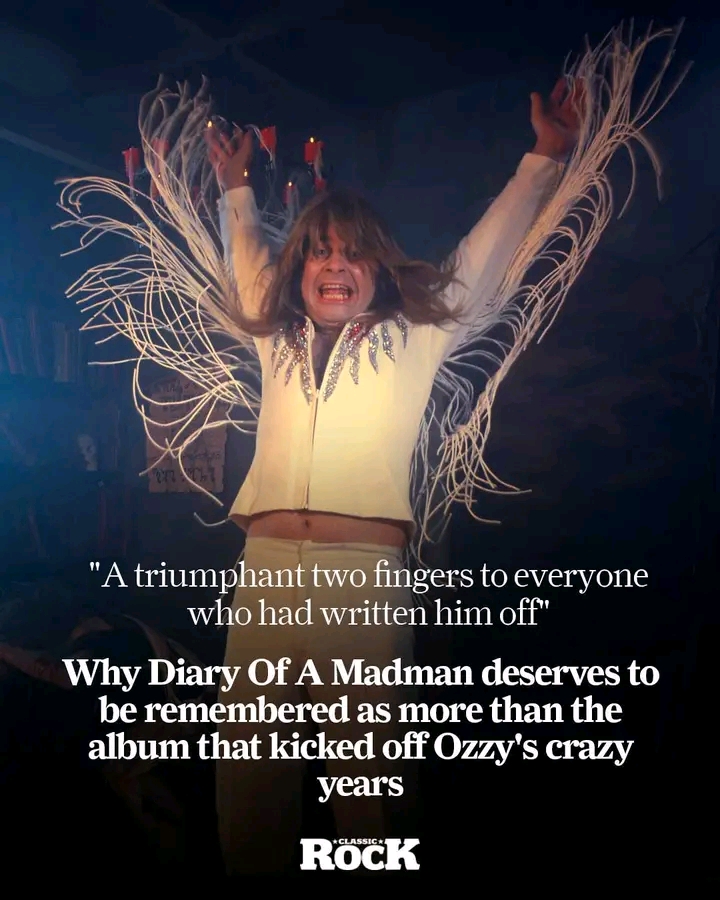
November 9, 1981 a date carved into heavy metal legend. On this day, Ozzy Osbourne released Diary of a Madman, his second solo studio album, and a record that would cement his transformation from exiled Sabbath frontman to the crowned Prince of Darkness. What began as a risky solo venture after his unceremonious exit from Black Sabbath became a monumental statement of defiance, creativity, and raw genius.
Just a year prior, Osbourne had stunned the rock world with his solo debut Blizzard of Ozz, which featured instant classics like “Crazy Train” and “Mr. Crowley.” But while Blizzard announced Ozzy’s rebirth, Diary of a Madman revealed his evolution deeper, darker, and far more dangerous.
The Band That Built a Monster
The lineup behind Diary of a Madman was lightning in a bottle: Ozzy Osbourne on vocals, Randy Rhoads on guitar, Lee Kerslake (formerly of Uriah Heep) on drums, and Bob Daisley (ex-Rainbow) on bass and lyrics. Together, they were less a backing band and more a creative brotherhood one that lived, breathed, and bled music.
According to Daisley, the chemistry was instant. “We didn’t just write songs we created worlds,” he once said. “Every riff, every lyric was about where Ozzy’s head really was.” And that headspace, as the title suggested, was chaotic, haunted, and yet strangely inspired.
In fact, the band’s bond was so tight that they recorded Blizzard of Ozz and Diary of a Madman back to back in 1980. Both were captured in the same feverish stretch of creativity with no idea which songs would go on which album. The result? A double-barreled blast of rock immortality that redefined what “solo Ozzy” would mean forever.
The Sound of Madness
From the gothic chime that opens “Over the Mountain” to the haunting orchestral finale of “Diary of a Madman,” the record plays like a descent into both genius and insanity.
Randy Rhoads’ guitar work was the beating heart of it all dazzlingly technical yet emotionally charged. On “Flying High Again,” he shredded with a grin; on “Believer,” he prowled like a ghost through Ozzy’s subconscious. And on the title track, he crafted one of the most spine-tingling solos in rock history, blending neoclassical scales with sheer emotional chaos.
It’s no exaggeration to say that Rhoads changed the face of guitar playing. Before Diary, metal guitarists were chasing volume. After Rhoads, they were chasing virtuosity. His work turned metal into an art form and his influence is still heard in players from Zakk Wylde to Synyster Gates.
But Diary of a Madman was more than a guitarist’s showcase. The entire album pulsed with creative tension. Kerslake’s drumming thundered like ritual drums, and Daisley’s lyrics gave Ozzy a narrative one torn between fame, faith, and madness. “You can’t kill rock and roll,” Ozzy screamed on track three, and it felt like both a warning and a prophecy.
The Controversy Behind the Curtain
Despite the magic in the studio, the story behind Diary of a Madman was marred by betrayal. When the album was released, only Ozzy and his new touring band Rudy Sarzo and Tommy Aldridge were credited on the sleeve. Daisley and Kerslake’s names were nowhere to be found.
For decades, fans assumed Sarzo and Aldridge played on the record. In truth, they hadn’t touched a note. It wasn’t until years later that Daisley and Kerslake’s roles were publicly acknowledged, after lawsuits, bad blood, and decades of debate.
To make matters worse, the 2002 reissue of the album replaced the original bass and drum tracks entirely with Ozzy’s then-bandmates re-recording the parts. Fans revolted, calling it “sacrilege.” The original recordings were finally restored in 2011, restoring Diary to its rightful form.
Tragedy and Legacy
Just months after the album’s release, tragedy struck. On March 19, 1982, Randy Rhoads was killed in a plane crash at just 25 years old. His death shattered Ozzy and marked the end of an era. Diary of a Madman became not just an album, but a memorial a final testament to Rhoads’ brilliance and the creative fire he shared with Ozzy.
Ozzy later said, “When Randy died, part of me died with him. Diary of a Madman is that part.”
And yet, the album’s legacy only grew. Critics who once dismissed it as theatrical excess later hailed it as a masterpiece of heavy metal storytelling. Rolling Stone would go on to rank it among the greatest metal albums of all time, praising its “perfect balance of melody, menace, and madness.”
The Enduring Madness
More than four decades later, Diary of a Madman still feels alive not frozen in nostalgia, but timeless in its emotion. Every generation of rock fans finds something new in it: the fear, the humor, the theatrical defiance that defined Ozzy’s persona.
Songs like “Tonight” and “S.A.T.O.” showcase his vulnerability, while “Over the Mountain” remains one of the most electrifying album openers in rock history. The closing title track, meanwhile, still feels like stepping inside the fractured mind of a man trying to survive his own legend.
It’s easy to forget that in 1981, Ozzy was written off by nearly everyone. Critics called him washed up, a joke, a casualty of excess. But Diary of a Madman silenced them all. It proved that Ozzy wasn’t just a frontman he was a survivor, a visionary, and a mad poet who turned chaos into symphony.
Forty-Four Years Later…
Today, Diary of a Madman stands not just as a metal milestone, but as a story of resurrection. It’s the sound of a man who lost everything his band, his confidence, his sanity and rebuilt himself through sheer will and wicked laughter.
In 2025, fans still crank it up and feel the same chill that hit the world in 1981. The thunder of Kerslake’s drums, the sorcery of Rhoads’ guitar, the haunted wail of Ozzy himself all echo through time, immortal.
Because madness, as Ozzy taught us, isn’t the end of the story. It’s where leg
ends begin.

Leave a Reply